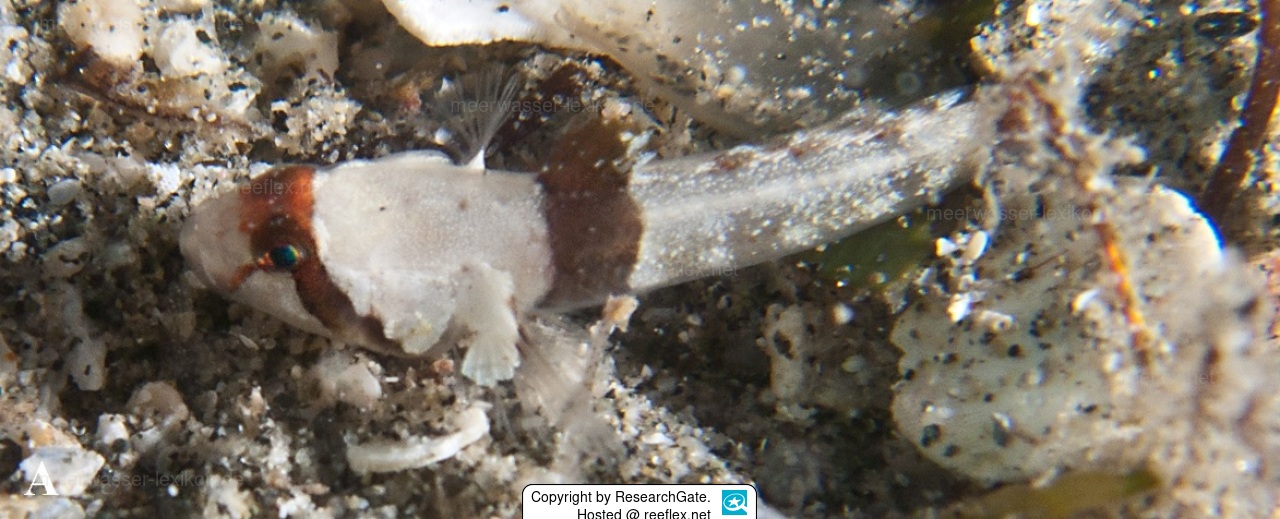Info
We like to thank Dr. Sergey Bogorodsky for the first photo of the goby Hetereleotris semisquamata.
The goby Hetereleotris semisquamata was first described only on the basis of the holotype (see photo, a female).
The female was discovered and collected on the reef plate of the seaward reef at Shams Alam, southern Egypt.
The head and body of the goby are opaque white, clearly prominent are the brown line and dark brown band on the head and a dark brown band under the first dorsal fin and a vertical dark brown band at the base of the caudal fin.
The head is mottled, the dorsal half is covered with dark brown dots, and the body has five indistinct vertical bars behind the band, densely covered with dark brown dots.
The caudal fin behind the vertical dark brown band has faint whitish and light brown areas.
Anal and pelvic fins are whitish, the anal fin has a blackish margin.
Pectoral fins are white at their base, the rest of the fins are translucent.
Etymology. The specific species name is derived from Latin "semi" meaning "half", and "squamata" meaning" scaly", referring to the unique scaling characterized by a wedge-shaped pattern in which the dorsal half of the anterior body and the abdomen remain completely naked.
Source:
Kovačić, Marcelo, Bogorodsky, Sergey V. & Mal, Ahmad O., 2019,
Two new species of Hetereleotris (Perciformes: Gobiidae) from the Red Sea
Zootaxa 4608 (3), pp. 501-516:
Jumping guard
A jumping guard prevents (nocturnal) fish from jumping out.
Wrasses, blennies, hawkfishs and gobies jump out of an unprotected tank in fright if their night rest is disturbed, unfortunately these jumpers are found dried up in the morning on carpets, glass edges or later behind the tank.
https://www.korallenriff.de/en/article/1925_5_Jump_Protection_Solutions_for_Fish_in_the_Aquarium__5_Net_Covers.html
A small night light also helps, as it provides the fish with a means of orientation in the dark!
The goby Hetereleotris semisquamata was first described only on the basis of the holotype (see photo, a female).
The female was discovered and collected on the reef plate of the seaward reef at Shams Alam, southern Egypt.
The head and body of the goby are opaque white, clearly prominent are the brown line and dark brown band on the head and a dark brown band under the first dorsal fin and a vertical dark brown band at the base of the caudal fin.
The head is mottled, the dorsal half is covered with dark brown dots, and the body has five indistinct vertical bars behind the band, densely covered with dark brown dots.
The caudal fin behind the vertical dark brown band has faint whitish and light brown areas.
Anal and pelvic fins are whitish, the anal fin has a blackish margin.
Pectoral fins are white at their base, the rest of the fins are translucent.
Etymology. The specific species name is derived from Latin "semi" meaning "half", and "squamata" meaning" scaly", referring to the unique scaling characterized by a wedge-shaped pattern in which the dorsal half of the anterior body and the abdomen remain completely naked.
Source:
Kovačić, Marcelo, Bogorodsky, Sergey V. & Mal, Ahmad O., 2019,
Two new species of Hetereleotris (Perciformes: Gobiidae) from the Red Sea
Zootaxa 4608 (3), pp. 501-516:
Jumping guard
A jumping guard prevents (nocturnal) fish from jumping out.
Wrasses, blennies, hawkfishs and gobies jump out of an unprotected tank in fright if their night rest is disturbed, unfortunately these jumpers are found dried up in the morning on carpets, glass edges or later behind the tank.
https://www.korallenriff.de/en/article/1925_5_Jump_Protection_Solutions_for_Fish_in_the_Aquarium__5_Net_Covers.html
A small night light also helps, as it provides the fish with a means of orientation in the dark!







 ResearchGate
ResearchGate


